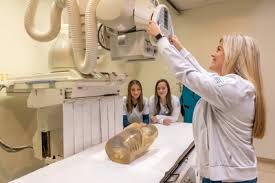Radiologic technology is a vital field in modern healthcare, combining advanced imaging techniques with patient care. As healthcare continues to evolve, the demand for skilled radiologic technologists, or rad techs, is on the rise. This article will provide an in-depth look at the rad tech program, covering everything from its curriculum and career opportunities to the skills required for success in this dynamic field.
1. What is a Rad Tech Program?
A rad tech program is an educational curriculum designed to train individuals in the field of radiologic technology. This program typically encompasses both theoretical knowledge and hands-on clinical experience. Students learn how to perform diagnostic imaging procedures using various technologies, such as X-rays, computed tomography (CT), magnetic resonance imaging (MRI), and ultrasound.
Overview of the Curriculum
Most rad tech programs are offered at the associate degree level, though some institutions offer bachelor’s degrees. The curriculum generally includes courses in anatomy, physiology, medical ethics, radiographic techniques, patient care, and radiation safety. In addition to classroom learning, students must complete a significant amount of clinical training to gain practical experience in a healthcare setting.
Importance of Accreditation
Accreditation is a crucial aspect of any rad tech program. Programs accredited by the Joint Review Committee on Education in Radiologic Technology (JRCERT) ensure that the curriculum meets national standards for education in radiologic technology. Graduating from an accredited program is often a prerequisite for taking the certification exam administered by the American Registry of Radiologic Technologists (ARRT).
2. The Role of Radiologic Technologists
Radiologic technologists play a crucial role in the healthcare system. They are responsible for performing imaging procedures that help physicians diagnose and treat medical conditions. The work of rad techs is not limited to operating imaging equipment; they must also ensure patient safety, provide comfort, and collaborate with other healthcare professionals.
Key Responsibilities
- Patient Interaction: Rad techs often interact directly with patients, explaining procedures and addressing any concerns they may have. Building rapport with patients is essential to ensure they feel comfortable during imaging exams.
- Equipment Operation: Technologists must have a thorough understanding of the imaging equipment they use. This includes knowledge of how to position patients, adjust settings, and ensure high-quality images are produced.
- Radiation Safety: Safety is paramount in radiologic technology. Technologists must follow strict protocols to minimize radiation exposure to patients and themselves. This includes using lead shields and monitoring radiation levels.
3. Pathway to Becoming a Radiologic Technologist
Educational Requirements
To become a radiologic technologist, prospective students typically need a high school diploma or equivalent. Following this, they must enroll in an accredited rad tech program. Most programs take about two years to complete for an associate degree, while bachelor’s programs may take four years.
Certification and Licensure
Upon completing a rad tech program, graduates must obtain certification from the ARRT. This involves passing a comprehensive exam that assesses their knowledge and skills in radiologic technology. Some states may also require licensure, which can involve additional testing or continuing education credits.
Continuing Education
Radiologic technology is an ever-evolving field, and technologists must stay current with new technologies, procedures, and safety protocols. Many states require rad techs to complete continuing education courses to maintain their certification and licensure.
4. Specializations within Radiologic Technology
Radiologic technology offers various specialization options for those looking to enhance their careers and expertise. Here are some of the most common specializations:
4.1. Computed Tomography (CT)
CT technologists specialize in operating computed tomography scanners, which create detailed cross-sectional images of the body. This specialization requires additional training and certification.
4.2. Magnetic Resonance Imaging (MRI)
MRI technologists are trained to use magnetic resonance imaging equipment, which uses strong magnets and radio waves to produce detailed images of organs and tissues. Similar to CT, MRI specialization requires further education and certification.
4.3. Ultrasound
Ultrasound technologists, or sonographers, utilize high-frequency sound waves to create images of internal structures. They often work closely with obstetricians and gynecologists to monitor pregnancies.
5. Career Opportunities and Job Outlook
The job outlook for radiologic technologists is promising, with the U.S. Bureau of Labor Statistics projecting a growth rate of about 7% from 2021 to 2031. This growth is driven by an aging population and advancements in medical imaging technology.
Work Environments
Radiologic technologists can find employment in various settings, including:
- Hospitals
- Outpatient clinics
- Imaging centers
- Physicians’ offices
- Research facilities
Salary Expectations
According to the U.S. Bureau of Labor Statistics, the median annual wage for radiologic technologists was approximately $61,900 as of May 2021. Factors influencing salary can include geographic location, years of experience, and specialization.
6. Skills Required for Success in Radiologic Technology
To thrive as a radiologic technologist, individuals must possess a unique combination of technical and interpersonal skills.
Technical Skills
- Equipment Proficiency: Understanding how to operate various imaging machines safely and effectively.
- Attention to Detail: Ensuring that images are of high quality and that patient records are accurate.
- Knowledge of Anatomy: A solid understanding of human anatomy and physiology is crucial for correctly positioning patients and interpreting images.
Interpersonal Skills
- Communication: Effectively communicating with patients, families, and healthcare teams to provide clear information and instructions.
- Compassion and Empathy: Providing emotional support to patients who may be anxious or in pain.
- Teamwork: Collaborating with physicians, nurses, and other healthcare professionals to ensure comprehensive patient care.
7. Case Studies: Success Stories in Radiologic Technology
Case Study 1: Advancements in Imaging Technology
A recent case study highlighted the integration of artificial intelligence (AI) in radiologic imaging. A hospital implemented AI algorithms to assist radiologic technologists in interpreting X-rays, leading to improved diagnostic accuracy and faster turnaround times. This advancement demonstrates the evolving role of technology in enhancing patient care and the importance of continuous education for rad techs.
Case Study 2: Community Outreach Programs
Another case study showcased a rad tech’s involvement in a community outreach program aimed at providing free screenings for low-income families. By offering essential imaging services, the technologist not only contributed to early disease detection but also fostered a sense of community trust in healthcare providers. This initiative underscores the significant role rad techs can play beyond their traditional clinical responsibilities.
8. Conclusion
The rad tech program is a gateway to a rewarding career in healthcare, offering diverse opportunities for growth and specialization. As the demand for skilled radiologic technologists continues to rise, individuals pursuing this career can expect a fulfilling profession that combines technology, patient care, and continuous learning.By understanding the educational requirements, job responsibilities, and career prospects, prospective students can make informed decisions about their future in radiologic technology. With a commitment to ongoing education and a passion for patient care, radiologic technologists can make a significant impact in the healthcare landscape.
This article provides a comprehensive overview of the rad tech program, detailing its significance in the healthcare field and the various pathways to becoming a radiologic technologist. Each section aims to inform and engage readers, offering valuable insights into this essential profession.





